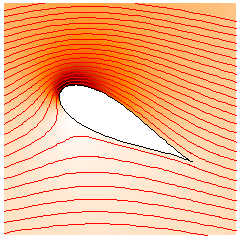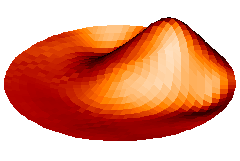
Yorick Examples
Flow past an airfoil
|
The Jakowski transform z --> z+a2/z maps a circle of radius a in the complex z-plane into a slot of length 4a. Slightly larger circles map to an airfoil shape you see in the picture to the right. Creating this picture required about 60 lines of yorick code, which you can study in the source file demo4.i. There, the get_mesh function creates a 120x30 mesh of complex numbers, uniformly distributed in radius and angle around the outside of a circle. The solve function distorts this uniform mesh into the shape you see by means of two Jakowski transformations, performed by the one-line jakowski function. At the same time, solve keeps track of the velocity potential, and finally computes the pressure field from Bernoulli's law and the velocity field. Finally, the display function uses yorick's plotting functions to draw the background shading (using plf) -- light where the pressure is high, and dark where the pressure is low -- contours of the imaginary part of the velocity potential (using plc) -- the flow lines -- and the outline of the airfoil itself (using plg). |

|
Drumhead motion
|
The picture to the right is one frame of a movie of a circular drumhead. The drumhead started with a bump in about the same location you see; it has fallen, split in half, run around to the opposite side of the drum, reflected, and returned to near its initial position at the time of this frame. The computational mesh is visible; it divides the circle into a 30x30 grid. This is one of three different kinds of movies of the same calculation, which you can study in the yorick source file demo2.i. Although yorick-1.5 has only 2D graphics, there are several packages that use interpreted code to do the geometry and lighting calculations to produce pictures like this one. However, this one was made using the pl3d function in demo2.i, rather than a general purpose routine like plwf. Yorick is fast enough that this movie, including both the wave solver (mostly the laplacian function in demo2.i) and the lighting and projection calculations, runs at about 20 frames per second on a 266 MHz Pentium II. |

|
LLNL Disclaimers